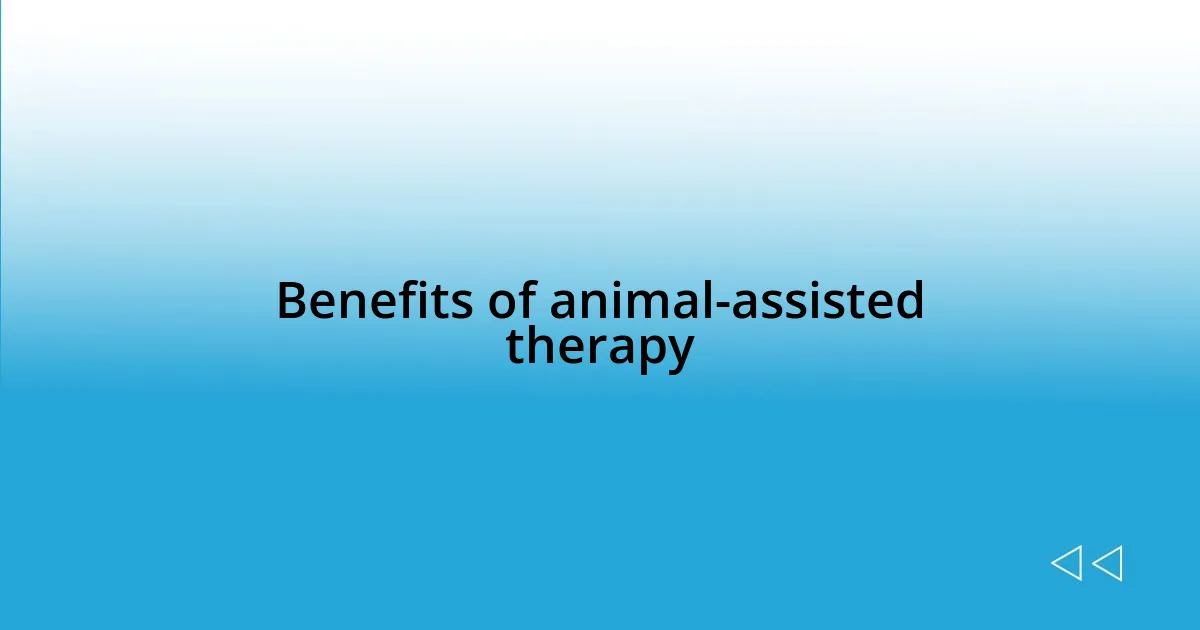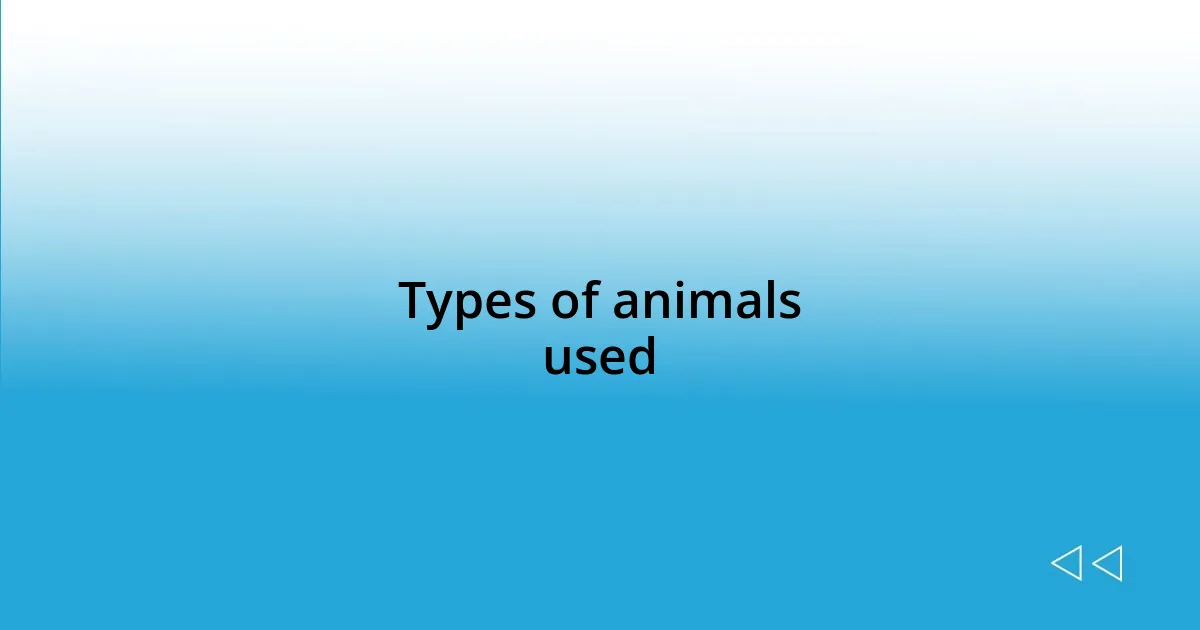Key takeaways:
- Animal-assisted therapy (AAT) utilizes animals to facilitate emotional healing, effectively addressing issues like anxiety, depression, and PTSD.
- Interacting with therapy animals can lead to reduced stress, improved mood, enhanced social interactions, and increased emotional expression.
- Various animals, such as dogs, cats, horses, and even dolphins, offer unique therapeutic benefits, demonstrating the versatility of AAT.
- Building a connection with animals fosters emotional regulation and understanding, paving the way for profound personal insights and healing experiences.

Understanding animal-assisted therapy
Animal-assisted therapy (AAT) involves the intentional use of animals to aid in human healing processes. I remember the first time I saw a therapy dog visiting patients in a hospital. It was incredible to witness the immediate joy and relaxation the dog brought to individuals who had been feeling isolated or anxious. Isn’t it fascinating how an animal’s presence can shift our mood almost instantly?
In my experience, AAT can target a range of emotional and psychological issues, such as anxiety, depression, and PTSD. For instance, I once spoke with a veteran who shared how working with horses helped him process his experiences. The gentle nature of the horses and the work of caring for them provided him with a sense of purpose and connection. Have you ever felt that deep bond with an animal that just makes the world feel a little less heavy?
As I delved deeper into the world of AAT, I found that the benefits extend beyond mere companionship. Studies suggest that interacting with animals can lower stress levels and improve overall mood. I’ve seen this firsthand; when I bring my dog to volunteering events, the smiles and laughter of people interacting with him are infectious. Isn’t it amazing how these furry companions can serve as catalysts for healing and transformation?

Benefits of animal-assisted therapy
Interacting with animals can create profound emotional and psychological benefits for individuals, which is something I’ve observed repeatedly in therapy settings. I remember sitting in on a session where a therapy dog worked with a child struggling with severe anxiety. The moment the child wrapped their arms around the dog, you could see the tension drain away, replaced by a sense of safety and joy. This powerful connection allows individuals to express emotions they might find challenging to vocalize.
The advantages of animal-assisted therapy extend to various areas of well-being, such as:
- Reduced Stress and Anxiety: Just petting a dog can lower cortisol levels, the hormone mainly responsible for stress.
- Enhanced Social Interactions: Therapy animals can facilitate conversations and connections among individuals, making it easier for them to engage with others.
- Improved Mood: The unconditional love an animal provides often leads to increased feelings of happiness and contentment.
- Increased Motivation: Working with animals can inspire individuals to be more active and engaged in their own healing journey.
- Emotional Improvement: A pet’s either playful nature or calm presence can encourage emotional expression and healing.
I’ve seen how these benefits can transform lives, making therapy seem less daunting and more approachable for many.

Types of animals used
Animals play a pivotal role in different forms of animal-assisted therapy. While dogs are the most commonly recognized therapy animals, other types, such as cats, horses, and even rabbits, also provide valuable support and companionship. I once encountered a therapy cat during a visit to a rehabilitation center, and its calm demeanor had a remarkable soothing effect on the patients. Can you imagine sitting with a fluffy cat purring gently in your lap, easing your worries? Each animal brings its own unique charm and benefits.
In my experience, many people respond differently to various animals, which is something worth considering. For instance, individuals dealing with trauma might connect more profoundly with horses, appreciating their large presence and gentle nature. I remember speaking to a woman who found immense comfort in horseback riding therapy, feeling empowered and loved by these magnificent creatures. Isn’t it intriguing how the connection can vary depending on the individual and the animal involved?
The diversity among therapy animals showcases the flexibility and adaptability of animal-assisted therapy. Animals like birds and even dolphins are being explored for their potential therapeutic benefits, tapping into different aspects of emotional healing. I once read about a program using dolphins in therapy sessions and how participants expressed joy and freedom during their interactions. This expanding range of animals reinforces how vital these creatures are in the healing process, making therapy more relatable and impactful for various individuals.
| Animal Type | Benefits |
|---|---|
| Dogs | Commonly provide companionship and are great for emotional support. |
| Cats | Known for their calming presence, they can reduce anxiety through simple interactions. |
| Horses | Help individuals build confidence and trust while facilitating emotional expression. |
| Rabbits | Offer comfort and companionship, especially in group therapy settings. |
| Dolphins | Engage participants in a unique environment, promoting joy and a sense of freedom. |

Personal experiences with therapy animals
Visiting a therapy center, I witnessed firsthand the impact therapy animals can have on individuals. In one session, a therapy goat ambled over to a young girl, who had previously been withdrawn and hesitant to engage. Watching her eyes light up as she gently reached out to pet the goat was a moment I won’t forget. It was as if the animal sensed her need for connection, and in that instant, barriers crumbled. Isn’t it incredible how such simple interactions can spark profound emotional responses?
I remember a time when I participated in a group therapy session with a dog named Max. His playful antics not only filled the room with laughter but also encouraged everyone to share their experiences more openly. I could feel the atmosphere shift; people who were once quiet and reserved began to open up, their laughter mingling with Max’s happy barks. There’s something about the lightness that a therapy animal brings that helps us lower our defenses. Doesn’t it just feel natural to share your thoughts when you’re surrounded by warmth and joy?
Another unforgettable moment occurred during my visit to an art therapy session where a rabbit named Hazel joined in. As we created our art, Hazel hopped around the room, and I noticed how participants would pause, reach down, and stroke her soft fur. It was a remarkable sight—how a small creature could weave its way into the fabric of healing art. I found myself reflecting on the power of presence—how simply being there with an animal could evoke memories and feelings that had long been buried. Can you recall a time when an unexpected source of comfort helped you find your voice?

Emotional and psychological impact
Engaging with therapy animals profoundly impacts emotional and psychological well-being. I recall a session with a therapy dog, Luna, who snuggled up to an elderly man experiencing loneliness. The shift in his demeanor was incredible; you could see the warmth of companionship wash over him as he placed a gentle hand on her back. There’s something healing about feeling the soft fur of an animal—like a silent understanding that says, “You’re not alone.” Have you ever felt that instant bond with a creature, where words are unnecessary?
In my observations, therapy animals often provide a unique non-verbal communication channel that fosters emotional expression. During one session, I noticed a group of participants hesitating to share their feelings. Then, a lively corgi dashed into the room, and suddenly, the energy shifted. One by one, participants began to recount their stories, smiles breaking through their previously guarded expressions. It’s fascinating how the mere presence of an animal seems to dissolve emotional barriers—how does it feel to witness that kind of breakthrough in a group setting?
From my experience, the psychological comfort derived from animal-assisted therapy isn’t solely about companionship; it’s also about the profound emotional regulation these animals can facilitate. I once facilitated a session where participants were encouraged to express their feelings by writing while cuddling a gentle rabbit. Many shared that the rabbit’s soft presence calmed their racing thoughts, allowing them to reflect more clearly. I believe that’s the magic of animal therapy; it invites us to explore our emotions in a safe space, prompting deeper self-discovery. How has interacting with animals helped you navigate your emotional landscape?

Building a connection with animals
When I think about building a connection with animals, one particular moment stands out vividly. During a session, I met a therapy cat named Whiskers. As I sat on the floor, she curled up in my lap, purring softly. In that instant, I felt a wave of calm wash over me; it was as if all my worries faded away. Isn’t it amazing how just being still with an animal can create such a deep sense of tranquility?
In another experience, I found myself bonding with a therapy horse named Charlie. As I gently brushed his coat, I noticed how his large, gentle eyes seemed to mirror my emotions. I began to share my thoughts aloud, and to my surprise, I felt completely understood. There was a raw honesty in that connection that we often overlook with our fellow humans. Have you ever experienced that profound understanding from an unexpected source?
Then there was the time I observed a group of children interacting with a therapy rabbit. Their laughter filled the room as they took turns petting her, and I could see the joy on their faces light up in a way that words couldn’t express. It struck me how the act of simply caring for an animal can forge bonds that help us connect not only with them but also with each other. Isn’t it fascinating how animals can serve as a bridge to our own emotions, allowing us to step outside ourselves and engage more fully with those around us?














